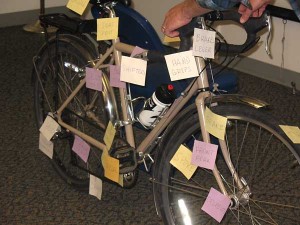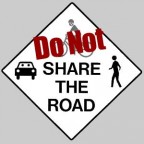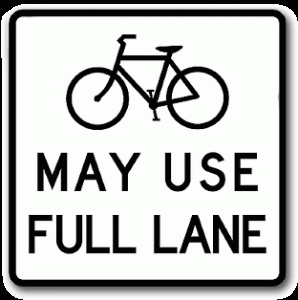Taking the Lane: You’re No Outlaw!

Better Bike spent last Saturday afternoon with a handful of other cyclists attending Confident City Cycling, an introductory cycling course. And confident cycling is indeed what’s on offer: Sustainable Streets co-founder Ron Durgin took us through the basics, from bike components to rules of the road, to prepare us well for safe cycling.
This class is a prerequisite for becoming a Licensed Cycling Instructor (LCI), a certification conferred by the League of American Bicyclists, a national advocacy group (and the only organization to license cycling instructors). LCI certification is a stamp of approval that is recognized by local governments, which are just now beginning to offer bike instruction (not in Beverly Hills, however).

This half of the course took us through the rules of the road – the theory behind safe cycling – while next week’s in-the-field half puts that theory into practice.
The law as it applies to cyclists is nicely illustrated in the Bike League’s Smart Cycling book; and in a California-specific primer on road rules titled, California Bicycling Street Smarts: Riding Confidently, Legally, and Safely. The latter is a must-read for any cyclist in California. Casual observation suggests that many motorists and not a few cyclists are uninformed about their responsibilities to other road users. (Both publications came complimentary with the class.)
How Do Road Rules Apply to Cyclists?
By way of a brief refrehser, cyclists have to follow the same rules of the road that motorists do; that means obeying traffic control devices, of course, but it also means exercising sufficient care to avoid conflict. (Bike attorney Bob Mionske talks about the need for cyclists to exercise care in his indispensable book, Bicycling and the Law. Read our review.) The vehicular code in section 21202 also requires of riders that they “ride as close as practicable to the right-hand curb or edge of the roadway.” That’s not always prudent given conditions, so it provides for the following exceptions:
- When overtaking or passing another bicycle or vehicle proceeding in the same direction;
- When preparing for a left turn at an intersection or into a private road or driveway;
- When approaching a place where a right turn is authorized; and most important here,
- When reasonable necessary to avoid conditions (inclusing but not limited to, fixed or moving objects, vehicles, bicycles, pedestrians, animals, surface hazards or substandard width lanes) that make it unsafe to continue along the right-hand curb or edge.”
The exception concerning the right hand lane is straightforward: when there exists a right turn lane, the cyclist who continues straight need move left, into the adjacent continuing traffic lane. To keep right against the curb or road edge risks getting right-hooked by a turning vehicle.
The exception for substandard-width lanes and road hazards is not so straightforward, however. ‘Substandard’ is not defined with precision in the vehicular code. In practice traffic lanes do vary from about 10 feet to 14 feet (or more), which requires guesswork. What is substandard anyway? The code offers a rough answer: ‘substandard’ is “too narrow for a bicycle and a vehicle to travel safely side by side within the lane.” While wide lanes may be safe to share, 10 foot lanes are too small to accommodate a bicycle and another vehicle like an SUV, bus or truck.
Road hazards provide another good reason not to share. Potholes, uneven pavement, debris, and those dreaded pavement grooves that catch tires near the right-hand curb or road edge all make cycling perilous. That’s why the code mandates the right-hand positioning only “where practicable” – not where possible. Toss in a few sewer grates, trash cans, stopped cars and the like, and before you know it you’ve got to take that lane. Inviting a motorist to share your lane can be frightening and even downright dangerous.
When Should I Take the Entire Lane?
 This got Better Bike thinking about just how often we need to command the lane as permitted by law. Because most travel lanes in urban Los Angeles are too narrow to share, most corridors without a dedicated on-road bike lane (or ‘Class II’ lane, in facilities parlance) should probably be considered not-sharable. That substandard-width lane is all for you.
This got Better Bike thinking about just how often we need to command the lane as permitted by law. Because most travel lanes in urban Los Angeles are too narrow to share, most corridors without a dedicated on-road bike lane (or ‘Class II’ lane, in facilities parlance) should probably be considered not-sharable. That substandard-width lane is all for you.

The more one cycles on our public roads, the more it seems we should claim that entire right-hand travel lane as ours. Between substandard-width roads, hazards, and car doors, marginalizing ourselves can only be problematic from a safety perspective. More and more, we’re taking that lane.
Of course, asserting one’s rights requires fortitude. Motorists can be intimidating bullies – they’re nearly anonymous behind the wheel and they’re well-equipped for a quick getaway. Nevertheless, when you feel that you can’t share the lane, move laterally toward the center and command it.
Sure, you may hear some dissatisfied honking, but if you’re in control you won’t be intimidated. Motorists will instinctively do what the CVC requires of them: they’ll move into the adjacent lane to pass, giving you the room you need. And in the absence of road facilities that make our travel more safe, we’ve got to take into our own hands measures allowed under the law to ensure that we safely coexist with motorists. Take that lane!

I would welcome a blitz tanirtgeg the people who flagrantly ignore traffic rules and endanger others as well as themselves. They give all cyclists a bad name.However the emphasis should be on endangerment and reasonableness, such as the sidewalk cycling in areas with high pedestrian traffic or bike lanes, as you mention above. I also get really irritated with people riding on the wrong side of the road or those who ignore traffic lights. The last thing we need is for officers to start handing out tickets left and right, for example, I strongly believe people riding on sidewalks along busy or narrow roads without bike lanes are making a rational judgment. That would just be one more thing to put people off using their bikes. We have such a small cycling population as it is and we need to do what we can to encourage others that it is safe. Having spoken to several police officers, I know they do understand the nuances, so I am hopeful that they would continue to keep this in mind if they decide to start handing out tickets.
I agree: riding responsibly is both the key to arriving safely, and to evolving the ‘bad bargain’ as I call it that accords risk to the cyclists (and too often automatically the fault too). I think it’s very plausible to demand individual responsibility from cyclists, and I think you’ll find most serious cyclists agree.
But I wince whenever I see a cyclist on the sidewalk; with the exception of small children, it’s a recipe for disaster. So
While cops do understand the nuance – and some have experience with bike patrols themselves – it’s the policymakers I worry about. Our T&P Commission’s first thought when pressed for safety improvements is law-breaking bikers.
Likewise, an earlier conversation with two City Council members gravitated toward a law to require helmets but conveniently overlook the city’s responsibility to make streets safe. When the safety-minded rational riders (like you say) find little choice but than take to the sidewalk, it suggests that we all have work to do: riders, policymakers, and transportation professionals. The latter are MIA in this whole discussion in BH.